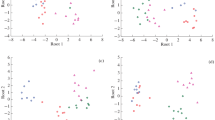Summary
The effects of phenelzine and 1,1-dideuterophenelzine (0.5 or 2.5 mg/kg/day) administered s.c. via miniosmotic pumps for 13 days were compared. Striatal levels of p-tryrosine and tryptophan were unaffected by either treatment. The concentrations of DOPAC, HVA and 5-HIAA were dose-dependently decreased by phenelzine and deuterated phenelzine; furthermore, the deuterated compound decreased the amounts of these acids more than the same dose of phenelzine. Dopamine levels were increased by a rather small amount by all drug treatments; no effects of drug dose or drug type (deuterated or nondeuterated) were observed. With the exception of phenylethylamine, qualitatively similar effects were found with all other amines measured; their amounts were increased dose-dependently and the effects of deuterated phenelzine were greater than those of phenelzine. Rat cerebral MAO activity was inhibited dose-dependently by phenelzine and by deuterated phenelzine. Type A MAO was inhibited more than type B, and deuterated phenelzine inhibited both types more than did phenelzine. The present study shows that the efficacy of phenelzine was increased about 5-fold by deuteration, that deuterated phenelzine increased tryptamine, m-tyramine and p-tyramine levels much more than it did the other monoamines, that phenylethylamine levels were least affected by the drug treatments, and that deuterated phenelzine inhibited MAO more than did phenelzine.
Similar content being viewed by others
Abbreviations
- D:
-
deuterium
- DOPAC:
-
3,4-dihydroxyphenylacetic acid
- 5HIAA:
-
5-hydroxyindole acetic acid
- HVA:
-
homovanillic acid
- MAO:
-
monoamine oxidase
- 3MT:
-
3-methoxytyramine
- 5-HT:
-
5-hydroxytryptamine
References
Belleau B, Moran J (1963) Deuterium isotope effects in relation to the chemical mechanism of monoamine oxidase. Ann NY Acad Sci 107:822–839
Birch PJ, Fillenz M (1985) The regulation of noradrenaline synthesis in central nerve terminals by autoreceptors and heteroreceptors in rat. Neurosci Lett 59:197–202
Blier P, de Montigny C, Azzaro AJ (1986) Modification of serotonergic and noradrenergic neurotransmissions by repeated administration of monoamine oxidase inhibitors: Electrophysiological studies in rat central nervous system. J Pharmacol Expt Therap 237:987–994
Clineschmidt BV, Horita A (1969) The monoamine oxidase catalysed degradation of phenelzine-1-14C, an irreversible inhibitor of monoamine oxidase. Biochem Pharmacol 18:1021–1028
Dewar KM, Dyck LE, Durden DA, Boulton AA (1987) Involvement of brain trace amines in the behavioural effects of phenelzine. Neurochem Res (in press)
Dewar KM, Dyck LE, Durden DA, Boulton AA. Effect of deuterium substitution on the penetration of β-phenylethylhydrazine into the brain. Biochem Pharmacol (in press)
Dourish CT, Dewar KM, Dyck LE, Boulton AA (1983) Potentiation of the behavioural effects of the antidepressant, phenelzine, by deuterium substitution. Psychopharmacology 81:122–125
Dyck LE, Durden DA, Yu PH, Davis BA, Boulton AA (1983) Potentiation of the biochemical effects of β-phenylethylhydrazine by deuterium substitution. Biochem Pharmacol 32:1519–1522
Juorio AV, Greenshaw AJ, Boulton AA (1986) Effects of acute and chronic phenelzine on regional monoamine metabolism in rats and its potentiation by deuterium substitution. Naunyn-Schmiedeberg's Arch Pharmacol 333:240–245
Kinemuchi H, Wakui Y, Kamijo K (1980) Substrate selectivity of type A and type B monoamine oxidase in rat brain. J Neurochem 35:109–115
Kwok RPS, Juorio AV (1986) Concentration of striatal tyramine and dopamine metabolism in diabetic rats and effect of insulin administration. Neuroendocrinology 43:590–596
Neff NH, Yang HYT (1974) Another look at the monoamine oxidases and the monoamine oxidase inhibitor drugs. Life Sci 14:2061–2074
Roth RH (1984) Dopamine autoreceptors: distribution, pharmacology and function. Ann NY Acad Sci 430:27–53
Schoepp DD, Azzaro AJ (1981) Specificity of endogenous substrates for types A and B monoamine oxidase in rat striatum. J Neurochem 36:2025–2031
Tipton KF, Spires IPC (1971) The kinetics of phenylethylhydrazine oxidation by monoamine oxidase. Biochem J 125: 521–524
Wu PH, Dyck LE (1976) Microassay for the estimation of monoamine oxidase activity. Anal Biochem 72:637–642
Yu PH, Barclay S, Davis B, Boulton AA (1981) Deuterium isotope effects on the enzymatic oxidative deamination of trace amines. Biochem Pharmacol 22:3089–3094
Zivin JA, Bartko JJ (1976) Statistics for disinterested scientists. Life Sci 18:15–26
Author information
Authors and Affiliations
Additional information
Send offprint requests to L. E. Dyck
Rights and permissions
About this article
Cite this article
Dyck, L.E., Juorio, A.V., Durden, D.A. et al. Effect of chronic deuterated and non-deuterated phenelzine on rat brain monoamines and monoamine oxidase. Naunyn-Schmiedeberg's Arch Pharmacol 337, 279–283 (1988). https://doi.org/10.1007/BF00168839
Received:
Accepted:
Issue Date:
DOI: https://doi.org/10.1007/BF00168839




